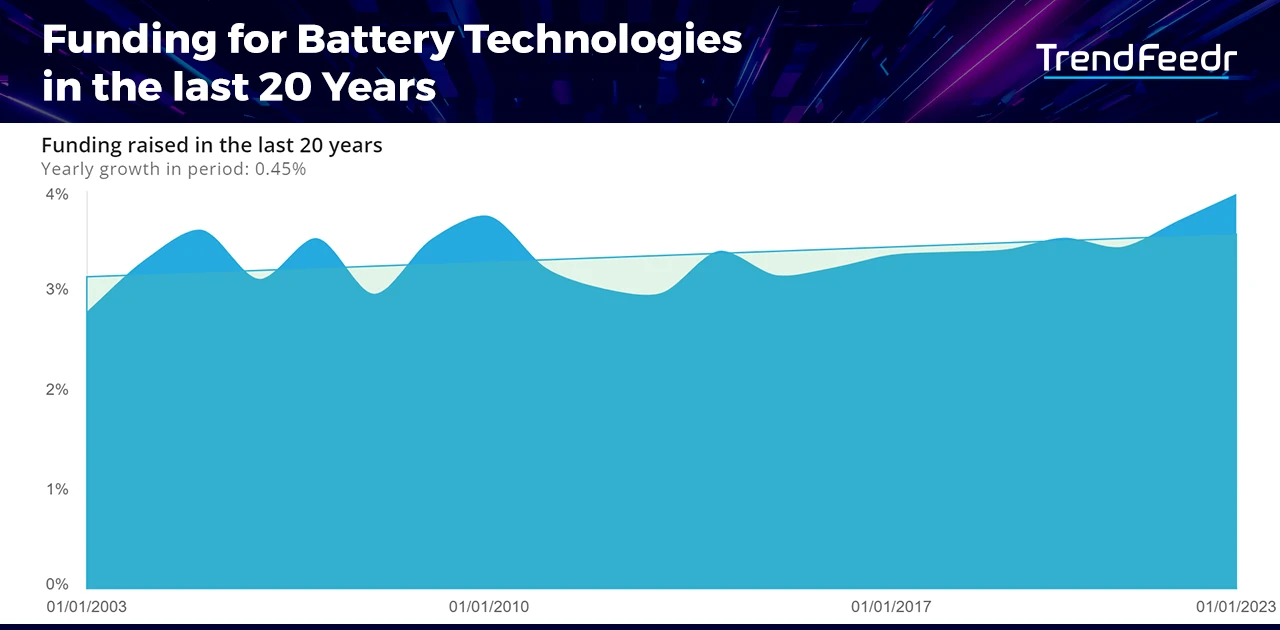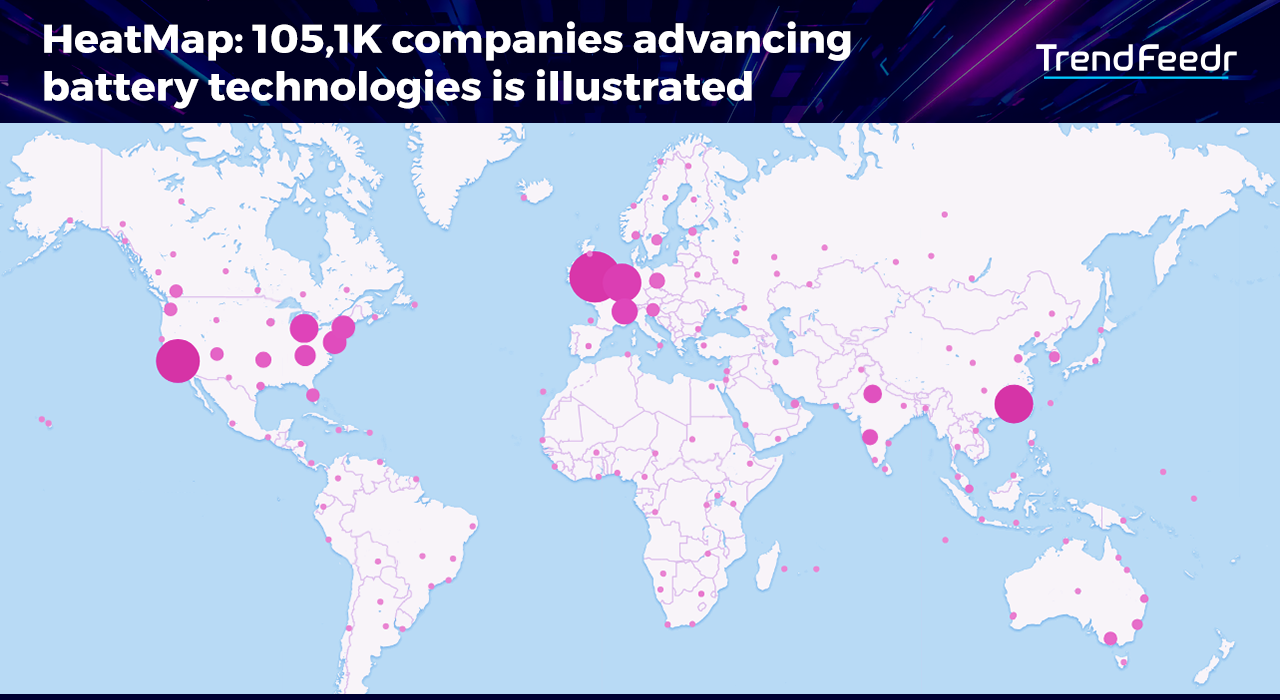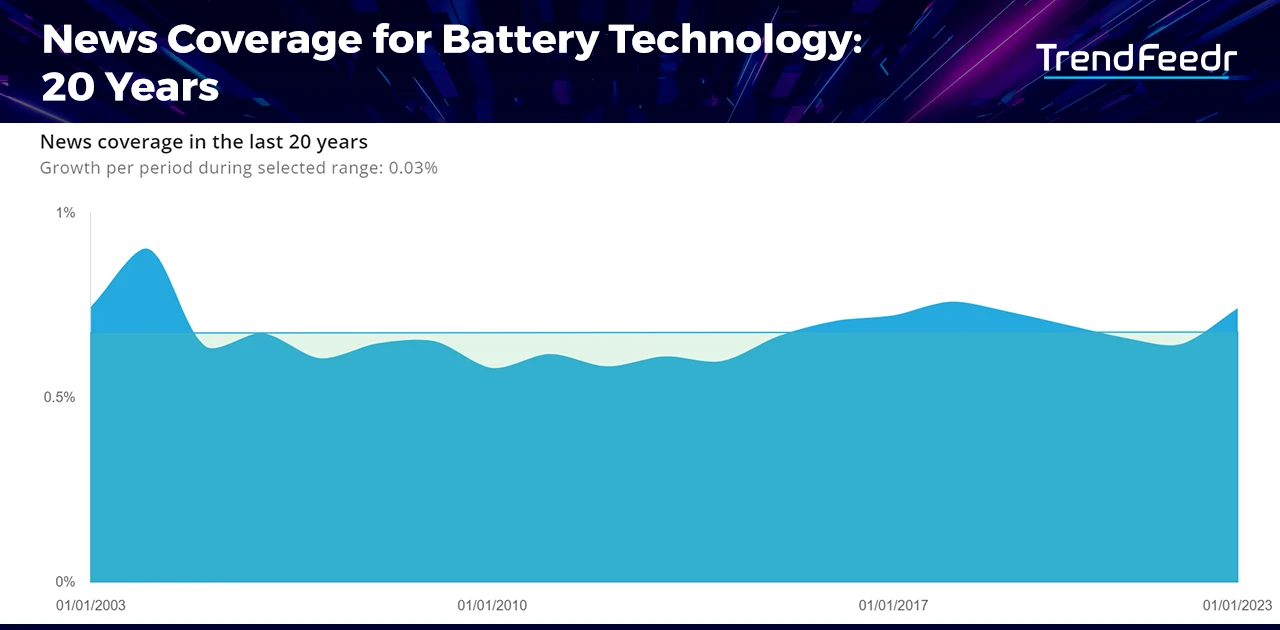Recent years have seen many exciting developments in battery technology. Researchers and companies are improving energy density, reducing charging time, and extending overall battery lifespan. For instance, some organizations are developing thin, flexible batteries made from cellulose. They find use in medical devices, wearables, and more. Additionally, ongoing research into self-healing batteries enables energy storage systems that repair themselves when damaged. Moreover, in the data-driven deep dive, we cover the latest trends in battery technology, including lead-acid, solid-state, li-ion, sodium-ion, and silicon batteries.
Businesses understand that these trends are not just a matter of curiosity, recognizing and leveraging them lead to groundbreaking advancements and strategic growth.
Key Takeaways
- Batteries – a growing global trend: Battery technology ranks in the top 0.3% of 20K+ trends covered by TrendFeedr. It has an annual growth rate of 0.79%, a trend magnitude of 99.61%, and a trend maturity of 52.02%.
- Diversifying rapidly: Battery technology firms are taking a multifaceted approach by engaging in related trends such as lead-acid, solid-state, li-ion, sodium-ion, and silicon batteries.
- Gradual expansion: New battery technology organizations have grown at a steady yearly rate of 0.21% in the last 20 years
- Business & Financial landscape: The total funding in battery technology is approximately $301.7 billion, with revenue estimated at 1.1 trillion.
- Leading investors include the US Department of Energy, Public Institutions, and General Motors, highlighting the significant financial backing in the field.
- Early adopters in battery technology include the US, India, China, Australia, and Germany, with key cities including Shenzhen, London, NYC, Sydney, and Bangalore.
Table of Contents
- Understanding Battery Technology: A Deep Dive into the Future of Power
- Battery Technology Performance Analysis: The Evolution of Energy & Power
- How Companies are Advancing the Battery Technology Trends
- How Battery Technology Disrupt Industries
- Unpacking the Investments in Battery Technology
- Geographical Activity: Mapping the Global Adoption of Battery Technology
- Future Outlook of Battery Technology
For this in-depth research of battery technology trends, we leverage TrendFeedr, our trend intelligence platform. TrendFeedr identifies future industry and tech trends via advanced, proprietary algorithms. With a focus on trend discovery, clustering, and analysis, the AI-powered platform screens thousands of trends each week to track their development and curate actionable insights.
Battery Technology has made a significant impact among the more than 20K+ trends and technologies monitored by TrendFeedr. Here’s why:
- It ranks in the top 0.3% globally, indicating its importance to industries and consumers worldwide.
- Compared to other trends, battery technology has a high magnitude of 99.61%, indicating widespread attention and investment.
- The rise of battery technology has been driven by the shift to electric vehicles (EVs), renewable energy storage, battery innovations, and demand for portable electronics.
In this trend report, we will delve into the fascinating world of battery technology, examining its performance, investment, industry, regional, and future trends. Our analysis will provide valuable insights into the economic viability and investment opportunities in this field, as well as support the development of more sustainable practices and technologies.
Understanding Battery Technology: A Deep Dive into the Future of Power
What is Battery Technology?
Battery technology focuses on the research, design, and production of energy storage devices. It involves the use of advanced materials and manufacturing processes to continuously improve the performance, efficiency, and durability of batteries. Battery technology companies develop batteries with higher energy density, longer lifespan, and lower cost. They also build innovative charging methods such as fast and wireless charging.
Further, battery technology plays a crucial role in the transition to a greener future. It enables the integration of renewable energy sources into modern infrastructures and promotes sustainable energy storage.
How are Businesses Leveraging Battery?
Businesses across various industries are capitalizing on advancements in battery technology. In the renewable energy sector, solar and wind farms are integrating large-scale battery storage systems to store excess energy for later use, stabilizing energy grids. Medical devices, such as pacemakers and portable medical equipment, leverage batteries for lifesaving functions.
Battery technology encompasses a wide range of chemistries and designs, including lithium-ion (Li-ion), lead-acid, nickel-metal hydride (NiMH), solid-state batteries, and flow batteries. Companies are leveraging these technologies to develop innovative products and solutions. For instance, QuantumScape develops solid-state battery technology to increase the range of electric cars.
Battery Technology Performance Analysis: The Evolution of Energy & Power
Introducing the Battery Trends Card, your gateway to a world of electrifying possibilities.
Battery technology is transforming the way we think about energy, with a trend magnitude of 99.61% and an annual growth rate of 0.79%. This steady growth reflects continual innovation, while the impressive trend magnitude signifies the technology’s wide-ranging impact. With a trend rank of 64, battery technology is among the top trends of all 20K+ trends covered by TrendFeedr, our all-in-one trend management tool. Despite being a mature field with a trend maturity of 52.02%, it is still full of emerging opportunities, indicating that the technology is far from reaching its peak.
Our Trend Card provides a comprehensive view of the battery technology landscape, including data on battery organizations and human resources available in the field. You also get to discover financial aspects such as funding and revenue provided by major investors supporting battery tech. Additionally, our analysis below covers the impact that battery technology has across industries, countries, and cities, offering a global perspective on its development.
Looking for all trends related to battery technology?
What is the latest in Battery Technology?
Companies specializing in battery technology are also at the forefront of innovation in other emerging trends. Here’s an exclusive overview of their diverse contributions to the future trends in battery technology based on the latest data from TrendFeedr.
Lead Acid Batteries
- This traditional technology remains a significant trend in energy storage, with 1503 organizations actively working in this field.
- It has received a total funding of $5 billion and employs a manpower of 167.6K, demonstrating both robust financial backing and significant human resources.
- Lead acid batteries continue to play a vital role in various applications, from automotive to grid energy storage.
Solid-State Batteries
- It is an emerging trend in the field of energy storage, with 242 organizations focusing on advancing solid-state batteries.
- With considerable funding of $4.5 billion and manpower of 18.8K, this area shows significant promise.
- Solid-state batteries offer improved safety and higher energy density, making them an attractive investment for the future.
Li-Ion Batteries
- These batteries are a dominant force in the battery technology market, with 1524 organizations, $14.5 billion in funding, and a substantial manpower of 123.9K involved.
- As the backbone of today’s portable electronics and EVs, Li-Ion batteries continue to drive innovation and investment in the field.
Sodium-Ion Batteries
- Sodium-Ion represents a niche yet growing trend in the field of energy storage, with 96 organizations, $682.5 million in funding, and a manpower of 7096 attributed to it.
- These types of batteries function as a more sustainable alternative to lithium, especially in large-scale energy storage applications.
- With their unique properties and potential for further development, sodium-ion batteries are an exciting area of research and investment in the battery technology landscape.
Silicon Batteries
- With only 37 organizations venturing into this emerging field of energy storage, the funding received is a staggering $1.6 billion.
- This is because silicon has long been considered a promising material for use in batteries, particularly as an anode material.
- Silicon can hold up to 10 times as many lithium ions by weight as graphite, the material currently used in most lithium-ion battery anodes
- The dedicated workforce of 2587 further underscores the industry’s belief in its promise.
The trends in the battery technology sector illustrate the diverse and multi-faceted engagement of companies in this field. Their involvement in various types of batteries not only showcases their adaptability. The trends also provide insight into the future directions these organizations may take as they continue to innovate and expand their horizons.
How Battery Technology Disrupts Industries
Automotive
The rise of electric vehicles (EVs) revolutionizes the automotive industry, with manufacturers such as Tesla, Nissan, and General Motors leading the pack. These companies rely on advanced lithium-ion batteries to power their cars. This contributes to reduced emissions and a shift towards more sustainable transportation.
Energy Storage and Grid Management
Batteries stabilize energy grids and facilitate the integration of renewable energy sources. Companies such as Siemens and ABB are utilizing battery storage systems to balance supply and demand, enhancing grid resilience and supporting the transition to cleaner energy sources like wind and solar. This contributes to the development of more sustainable and reliable energy systems in the energy sector.
Consumer Electronics
Lithium-ion batteries are the driving force behind the functionality of smartphones, laptops, and other portable devices. Brands such as Apple and Samsung leverage advancements in battery technology to create devices with longer battery life and rapid charging capabilities, enhancing the user experience and convenience. This enables the development of more efficient and reliable portable devices in the consumer electronics industry.
Medical Devices
Battery technology powers essential medical devices such as pacemakers, hearing aids, and portable medical equipment. For example, Medtronic relies on advanced battery solutions to develop life-saving technologies that offer mobility and reliability to patients. The use of battery technology in the medical field enables the development of more efficient and reliable medical devices, improving patient outcomes and enhancing the quality of care.
Aerospace and Defense
The aerospace and defense industries utilize innovative battery solutions in drones, satellites, and other aerospace applications. Companies such as Boeing and SpaceX use batteries to power certain functions within their aircraft and spacecraft, with a focus on energy efficiency and weight reduction.
Industrial Equipment
In the industrial equipment sector, forklifts, mining equipment, and other heavy machinery are increasingly utilizing battery power. Caterpillar and Komatsu are incorporating battery technology into their equipment to increase efficiency and reduce environmental impact.
Marine Industry
In the marine sector, the shipping industry explores battery technology to reduce its reliance on traditional fossil fuels. Companies such as Rolls-Royce are developing hybrid and fully electric vessels, paving the way for more sustainable maritime transport. The incorporation of advanced battery technology into the marine industry significantly reduces emissions and improves efficiency.
The profound impact of battery technology across diverse industries illustrates its versatility and potential. Batteries are at the core of modern technological advancement, powering our daily gadgets and transforming the way we travel and conduct business. This widespread application across top industries emphasizes the critical role of battery technology in shaping the future, not only as an energy solution but also as a key driver of innovation and sustainability.
New Organizations Working with Battery Technologies
Battery technology has garnered the attention of numerous entities due to its significance and potential. Approximately 105.1K organizations are actively developing advanced power solutions.
Over the past 20 years, there has been a steady yearly growth rate of 0.21% in the emergence of new organizations working with battery technology. Each new organization represents a step towards new solutions, novel applications, and groundbreaking inventions, indicating a creating an ecosystem continually shaping the future of power.
Below is the collection of the top 5 battery startups:
- Recyclus Group – A leading provider of battery recycling services, catering to the automotive, aviation, and heavy vehicle markets.
- Batx Energies – A producer of battery-grade materials by recycling end-of-life lithium-ion batteries, creating a sustainable and eco-friendly energy source.
- INEM Technologies – A developer of innovative nanomaterials for energy applications.
- Factorial Energy – A manufacturer of nano-engineered batteries designed for use in electric vehicles, homes, and critical applications.
- Sicona Battery Technologies – A developer of lithium-ion battery materials, specializing in the commercialization of silicon-graphite-carbon anode materials and binders for the storage of renewable energy.
Who Invests in Battery Technology
Financial backing for battery technology, or battery investments is impressive, with total funding in the top 5% bracket of all 20K+ trends covered by TrendFeedr, our trend intelligence tool.
The US Department of Energy is at the forefront of investments in battery technology. It has investments in 31 organizations totaling $12.5 billion. This includes top investments in BlueOval SK at $9.2 billion and Ioneer at $700 million.
Public institutions have also made significant contributions, investing in 188 organizations for a total of $11.8 billion. Notable investments by public institutions include Ganzhou Tengyuan Cobalt New Material at $859.7 million and Shenzhen Hello Tech Energy at $832 million.
Private players such as General Motors have also made substantial contributions. It funded 8 organizations including Lithium Americas at $650 million and Lordstown Motors at $500 million.
Moreover, a diverse range of unique investors has shown interest in battery companies to invest in, placing battery technology in the top 5% of all trends globally.
The line chart depicting the funding raised over the past 20 years reveals a consistent yearly growth of 0.45%. This underscores the long-term confidence investors have shown in battery technology. The steady growth and continued support from investors is a positive sign for its future development.
Further, the battery technology sector has demonstrated significant strength in terms of manpower. The industry has a total count of 7.1 million employees, an average of 95, and a median of 15 per organization.
Additionally, the field experiences substantial employee growth, with a total of 421.8K new hires yearly and a maximum of 445 in a single organization. The sector sees an average of 7 and a median of 2 new employees across various organizations. This data reflects the vitality and progressive expansion of the battery technology sector, attracting both large-scale and specialized talent.
Funding Overview of Battery Technology Companies
According to TrendFeedr, the total funding involved in battery technology amounts to $301.7 billion. The average funding is $32.3 million and the median is $1.6 million. This highlights the vast monetary backing driving innovations and scalability in the industry.
TrendFeedr estimates that the total revenue stands at an impressive $1.1 trillion. For this, the maximum revenue is $1 billion, the average is $14.8 million, and the median is $2.5 million. These numbers shed light on the enormous economic impact and market potential of battery technology.
The most prominent funding types in the industry include Grants, Early-Stage VC/Series A, Seed, Venture Round, and Later-Stage VC/Series C. Moreover, grants stand out in funding battery technologies, totaling 2517 in number and comprising 1.56% of the funding.
Geographical Activity: Mapping the Global Adoption of Battery Technology
The global distribution of the 105.1K companies involved in battery technology is illustrated in the map below.
Interested to explore all 105K+ battery technology companies?
The United States leads in terms of countries, with a robust network of innovation and investment. China’s manufacturing strength and Germany’s focus on clean energy also make them key players. India and Australia have experienced substantial growth, driven by India’s focus on sustainable development and Australia’s natural resources, although Australia has seen a more modest increase, potentially reflecting regulatory challenges.
In terms of cities, Shenzhen’s manufacturing capabilities and Bangalore’s tech-driven ecosystem have fostered thriving environments for battery technology. London and New York City have also seen growth along with other major cities. Sydney’s prominent position in the battery technology map has experienced an increase, highlighting its capability to build batteries that significantly reduce energy costs.
Battery Technology’s Media Coverage Remains Consistent
Battery technology has seen a surge in publication coverage, ranking it in the top 5% among all trends. The volume of articles dedicated to the topic also places it in the top 5% of trending topics.
The enduring relevance of battery trends is illustrated by the average yearly monthly news coverage over the past 20 years. This provides insight into the public’s growing interest in battery technology. With a steady yearly growth of 0.03%, media attention has not only remained stable but has also seen a slight increase. This reflects a technological field that continues to captivate, innovate, and promise new frontiers.
What is the Future of the Battery Industry?
Based on current data and projections, the trend of battery technology is poised to continue shaping the future. Here’s a glimpse into what the future holds for this rapidly evolving trend:
Increased Energy Density
The limitations of current battery capacities pose a significant challenge to the longevity of device operation. In the future, batteries are expected to offer higher energy storage capacities. This allows for longer runtimes in devices and greater distances for EVs without the need for frequent charging. Moreover, this increased energy density will enable the development of more efficient and reliable battery-powered systems.
Integration with Renewable Energy
Batteries are expected to play a key role in the adoption of renewable energy. It allows for efficient energy storage and smoothing out the intermittency of wind and solar energy sources. The integration of advanced battery technology with renewable energy sources will enable the development of more sustainable and reliable energy systems. This, in turn, aids the transition to cleaner energy sources and decarbonized grids.
Widespread Adoption in Transportation
Conventional modes of transportation are a major contributor to global carbon emissions. Battery technology is expected to further penetrate the transportation sector. This will enable cleaner and more efficient modes of travel, impacting the automotive, maritime, and aviation industries. The widespread adoption of advanced battery technology in these fields will facilitate the development of more sustainable and reliable transportation systems.
Enhanced Safety Measures
Continued research in battery technologies is expected to lead to the development of batteries with enhanced safety features. This reduces the risk of overheating and other failure modes. Consequently, these enhanced safety features, including battery management systems, will improve the reliability and performance of battery-powered systems.
Global Collaboration and Regulations
The lack of uniform international standards and regulations for the production and disposal of batteries can result in inefficiencies and safety concerns. In the future, we can expect to see more international collaboration and regulations governing battery development, use, and disposal. This will ensure responsible growth and global standardization in the field of battery technology.
Rapid Growth in Emerging Markets
Countries such as India and China are expected to continue to be hotspots for growth in terms of battery manufacturing and utilization. This growth is evident in the automotive and renewable energy sectors. The rapid growth of battery technology in these emerging markets highlights its potential to drive innovation and improve the lives of people.
How can you stay updated with the rapidly evolving landscape of battery technology?
With the growing demand for portable devices and a shift towards renewable energy storage, battery technology is undergoing a revolution. Innovations are aimed at making batteries more efficient, safer, and environmentally friendly.
To keep abreast of these trends and capitalize on opportunities, it is important to connect with industry professionals, thought leaders, and innovators. This can provide valuable insights and opportunities for collaboration. Additionally, staying informed by reading industry reports, attending webinars and conferences, and engaging in relevant online communities can help you stay up-to-date with emerging trends in battery technology. Utilizing a trend intelligence platform, such as TrendFeedr, can also be an effective way to stay informed about the latest developments.
By engaging in these activities, you can make informed decisions about your investments and business strategies in the rapidly evolving battery technology landscape.








